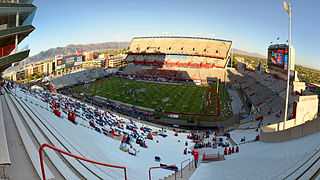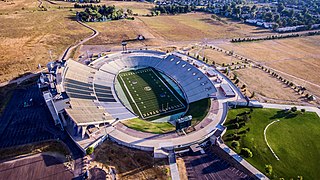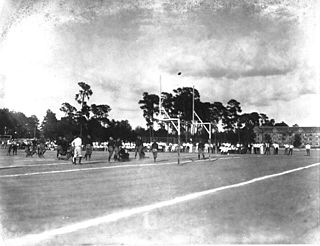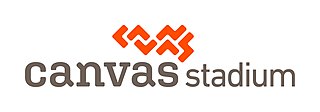
CEFCU ('sef-kyü) Stadium, formerly known as Spartan Stadium, is an outdoor athletic stadium on the west coast of the United States, located in the Spartan Keyes neighborhood of central San Jose, California. Owned by San José State University, the venue is the longtime home of Spartan football; it also hosts the university's commencement ceremony on Memorial Day weekend, and occasional high school football games. Known as Spartan Stadium for over eight decades, it was renamed in 2016.

FirstBank Stadium is a football stadium located in Nashville, Tennessee. Completed in 1922 as the first stadium in the South to be used exclusively for college football, it is the home of the Vanderbilt University football team. When the venue was known as Vanderbilt Stadium, it hosted the Tennessee Oilers during the 1998 NFL season and the first Music City Bowl in 1998 and also hosted the Tennessee state high school football championships for many years.

Amon G. Carter Stadium is an open-air football stadium on the campus of Texas Christian University in Fort Worth, Texas. It is the home stadium of the TCU Horned Frogs football team. It is named after Amon G. Carter, a prominent Fort Worth businessman, newspaper publisher, and city booster. Amon G. Carter stadium has several popular nicknames, the most popular being "The Carter" and "Hell's Half Acre".

Arizona Stadium is an outdoor college football stadium in the southwestern United States, located on the campus of the University of Arizona in Tucson, Arizona. It is the home field of the Arizona Wildcats of the Big 12 Conference.

Folsom Field is an outdoor college football stadium located on the campus of the University of Colorado in Boulder, Colorado. It is the home field of the Colorado Buffaloes of the Big 12 Conference.

Dix Stadium is a stadium in Kent, Ohio, United States. It is primarily used for American football, and is the home field of the Kent State Golden Flashes football team. In addition, since 2016 the stadium is also home to the Kent State women's soccer team and since 2019 to the women's lacrosse team. Previously, it was home to the Kent State field hockey team from 1997 to 2004 and served as a secondary home for the KSU men's soccer team in the 1970s. It opened on September 13, 1969 and was named in 1973 after Robert C. Dix, former publisher of the Record-Courier and a member of Kent State's Board of Trustees for more than three decades. It was built as an expansion and relocation of Memorial Stadium, with all of Memorial Stadium's main seating areas used at the current stadium in a new configuration. During soccer games, the playing surface is known as Zoeller Field.

Sonny Lubick Field at Hughes Stadium was an outdoor college football stadium in the western United States, located in Fort Collins, Colorado. It was the home field of the Colorado State Rams of the Mountain West Conference from 1968 through 2016; the team moved in 2017 to the new on-campus Colorado State Stadium.

LaVell Edwards Stadium is an outdoor athletic stadium in the western United States, on the campus of Brigham Young University (BYU) in Provo, Utah. Primarily used for college football, it is the home field of the BYU Cougars, a member of the Big 12 Conference in the Football Bowl Subdivision. Opened as "Cougar Stadium" in 1964, its seating capacity is 62,073. Following the 2024 departure of Oklahoma and Texas for the Southeastern Conference, it is the largest permanent stadium in the Big 12.

Wallace Wade Stadium, in full Brooks Field at Wallace Wade Stadium, is a 35,018-seat outdoor stadium in the southeastern United States, located on the campus of Duke University in Durham, North Carolina. Primarily used for American football, it is the home field of the Duke Blue Devils of the Atlantic Coast Conference.

Charles M. Murphy Athletic Center is the name of the main athletic department building at Middle Tennessee State University in Murfreesboro, Tennessee. The building opened December 11, 1972, and is named in honor of former athletics director Charles M. "Bubber" Murphy, a standout athlete at the college in the 1930s, who also served as head coach of Middle Tennessee State's football (1947–1968), basketball (1948–1949), and baseball programs.

Cessna Stadium is a stadium on the campus of Wichita State University in Wichita, Kansas, United States. It opened in 1946 and served as the home of the football team until the program was discontinued in 1986. It is currently home of the Wichita State Shockers track and field team. The Kansas Board of Regents approved demolition of the stadium in April 2020. Only the east stands were demolished. The rest of the stadium is supposed to be demolished after the 2024 track and field season.

Jack Coffey Field is a 7,000-seat multi-purpose stadium located on the campus of Fordham University in The Bronx, New York. It is the Fordham Rams' home for football, men's and women's soccer, and baseball. The facility opened for baseball 95 years ago in 1930, and was named in 1954 for baseball coach and longtime athletic director Jack Coffey, four years before his 1958 retirement.

The Colorado State Rams are the athletic teams that represent Colorado State University (CSU). Colorado State's athletic teams compete along with 8 other institutions in the Mountain West Conference, which is an NCAA Division I conference and sponsors Division I FBS football. The Conference was formed in 1999, splitting from the former 16-member Western Athletic Conference. CSU has won nine MWC tournament championships and won or shared 11 regular season titles. Rams football teams won or shared the Mountain West title in 1999, 2000 and 2002.

Wendel D. Ley Track and Holloway Field is a stadium in Houston, Texas. It is primarily used for track and field and soccer for the Rice University Owls. It is bounded by Main Street (southeast), University Boulevard (southwest), Reckling Park baseball field (west) and open athletic fields (north).

Harry Walker Hughes was an American football player, coach of football, basketball, baseball, and track, and college athletics administrator. From 1911 to 1941, he served as the head football coach and athletic director at the Agricultural College of Colorado, renamed Colorado A&M in 1935 and now known as Colorado State University, compiling a record of 126–96–18.

Memorial Stadium was a multi-purpose stadium in Kent, Ohio, United States, on the campus of Kent State University. Its primary use was as the home field for the Kent State Golden Flashes football team and also served as the home venue for the KSU men's track and field team. The football and track teams had already been playing on the site since 1941, but with temporary bleachers for seating. The permanent grandstand built and dedicated in 1950, which also included a press box, was the first phase of the stadium, and was later followed by a duplicate grandstand on the opposite side of the field in 1954. Initial plans called for the seating to eventually surround the field, though these plans were largely never realized. During the 1960s, additional bleacher seats were added separate from the two main grandstands on all sides of the field, and brought seating capacity to approximately 20,000 by 1965.

The Colorado State Rams football program represents Colorado State University and is a member of the NCAA Division I Football Bowl Subdivision and the Mountain West Conference. The Rams have long-standing rivalries with Colorado, Wyoming, and Air Force. The team is currently led by head coach Jay Norvell, who was hired in December 2021.

Albertsons Stadium is an outdoor athletic stadium in the Western United States, located on the campus of Boise State University in Boise, Idaho. It is the home of the Boise State Broncos of the Mountain West Conference. Known as Bronco Stadium for its first 44 seasons, it was renamed in May 2014 when Albertsons, a chain of grocery stores founded by Boise area resident Joe Albertson, purchased the naming rights.

Fleming Field was the first on-campus home for the football and baseball teams representing the University of Florida in Gainesville. Construction began in 1910, and the facility debuted as the home field for Florida Gators outdoor sports programs during the spring semester of the 1910-1911 academic year.

Canvas Stadium, officially Sonny Lubick Field at Canvas Stadium, is an outdoor college football stadium in the western United States, located on the campus of Colorado State University (CSU) in Fort Collins, Colorado.






















